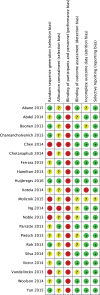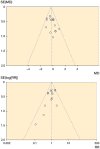Patient-specific instrumentation does not improve radiographic alignment or clinical outcomes after total knee arthroplasty
- PMID: 27249110
- PMCID: PMC4967282
- DOI: 10.1080/17453674.2016.1193799
Patient-specific instrumentation does not improve radiographic alignment or clinical outcomes after total knee arthroplasty
Abstract
Background and purpose - Patient-specific instrumentation (PSI) for total knee arthroplasty (TKA) has been introduced to improve alignment and reduce outliers, increase efficiency, and reduce operation time. In order to improve our understanding of the outcomes of patient-specific instrumentation, we conducted a meta-analysis. Patients and methods - We identified randomized and quasi-randomized controlled trials (RCTs) comparing patient-specific and conventional instrumentation in TKA. Weighted mean differences and risk ratios were determined for radiographic accuracy, operation time, hospital stay, blood loss, number of surgical trays required, and patient-reported outcome measures. Results - 21 RCTs involving 1,587 TKAs were included. Patient-specific instrumentation resulted in slightly more accurate hip-knee-ankle axis (0.3°), coronal femoral alignment (0.3°, femoral flexion (0.9°), tibial slope (0.7°), and femoral component rotation (0.5°). The risk ratio of a coronal plane outlier (> 3° deviation of chosen target) for the tibial component was statistically significantly increased in the PSI group (RR =1.64). No significance was found for other radiographic measures. Operation time, blood loss, and transfusion rate were similar. Hospital stay was significantly shortened, by approximately 8 h, and the number of surgical trays used decreased by 4 in the PSI group. Knee Society scores and Oxford knee scores were similar. Interpretation - Patient-specific instrumentation does not result in clinically meaningful improvement in alignment, fewer outliers, or better early patient-reported outcome measures. Efficiency is improved by reducing the number of trays used, but PSI does not reduce operation time.
Figures






Similar articles
-
Computer-assisted surgery and patient-specific instrumentation improve the accuracy of tibial baseplate rotation in total knee arthroplasty compared to conventional instrumentation: a systematic review and meta-analysis.Knee Surg Sports Traumatol Arthrosc. 2022 Aug;30(8):2654-2665. doi: 10.1007/s00167-021-06495-x. Epub 2021 Mar 1. Knee Surg Sports Traumatol Arthrosc. 2022. PMID: 33646370
-
Small improvements in mechanical axis alignment achieved with MRI versus CT-based patient-specific instruments in TKA: a randomized clinical trial.Clin Orthop Relat Res. 2014 Oct;472(10):2913-22. doi: 10.1007/s11999-014-3784-6. Epub 2014 Jul 15. Clin Orthop Relat Res. 2014. PMID: 25024031 Free PMC article. Clinical Trial.
-
Patient-specific instrumentation improved axial alignment of the femoral component, operative time and perioperative blood loss after total knee arthroplasty.Knee Surg Sports Traumatol Arthrosc. 2019 Apr;27(4):1083-1095. doi: 10.1007/s00167-018-5256-0. Epub 2018 Oct 30. Knee Surg Sports Traumatol Arthrosc. 2019. PMID: 30377714 Free PMC article. Review.
-
Component alignment and clinical outcome following total knee arthroplasty: a randomised controlled trial comparing an intramedullary alignment system with patient-specific instrumentation.Bone Joint J. 2016 Aug;98-B(8):1043-9. doi: 10.1302/0301-620X.98B8.37240. Bone Joint J. 2016. PMID: 27482015 Clinical Trial.
-
Computer navigation for total knee arthroplasty achieves better postoperative alignment compared to conventional and patient-specific instrumentation in a low-volume setting.Orthop Traumatol Surg Res. 2018 Nov;104(7):971-975. doi: 10.1016/j.otsr.2018.04.003. Epub 2018 Apr 25. Orthop Traumatol Surg Res. 2018. PMID: 29704634
Cited by
-
Use of Patient-Specific Instrumentation (PSI) for glenoid component positioning in shoulder arthroplasty. A systematic review and meta-analysis.PLoS One. 2018 Aug 22;13(8):e0201759. doi: 10.1371/journal.pone.0201759. eCollection 2018. PLoS One. 2018. PMID: 30133482 Free PMC article.
-
Patient-Specific Instrumentation Accuracy Evaluated with 3D Virtual Models.J Clin Med. 2021 Apr 1;10(7):1439. doi: 10.3390/jcm10071439. J Clin Med. 2021. PMID: 33916110 Free PMC article.
-
The Bony Resection Accuracy with Patient-Specific Instruments during Total Knee Arthroplasty: A Retrospective Case Series Study.Biomed Res Int. 2021 Feb 15;2021:8674847. doi: 10.1155/2021/8674847. eCollection 2021. Biomed Res Int. 2021. PMID: 33644230 Free PMC article. Clinical Trial.
-
Computer-assisted surgery and patient-specific instrumentation improve the accuracy of tibial baseplate rotation in total knee arthroplasty compared to conventional instrumentation: a systematic review and meta-analysis.Knee Surg Sports Traumatol Arthrosc. 2022 Aug;30(8):2654-2665. doi: 10.1007/s00167-021-06495-x. Epub 2021 Mar 1. Knee Surg Sports Traumatol Arthrosc. 2022. PMID: 33646370
-
Surgery Training and Simulation Using Virtual and Augmented Reality for Knee Arthroplasty.Cureus. 2022 Sep 6;14(9):e28823. doi: 10.7759/cureus.28823. eCollection 2022 Sep. Cureus. 2022. PMID: 36225417 Free PMC article. Review.
References
-
- Abane L, Anract P, Boisgard S, Descamps S, Courpied J P, Hamadouche M.. A comparison of patient-specific and conventional instrumentation for total knee arthroplasty: A multicentre randomised controlled trial. Bone Joint J 2015; 97-B (1): 56–63. - PubMed
-
- Barrack R L, Ruh E L, Williams B M, Ford A D, Foreman K, Nunley R M.. Patient specific cutting blocks are currently of no proven value. J Bone Joint Surg Br 2012; 94 (11 Suppl A): 95–9. - PubMed
-
- Bell S W, Young P, Drury C, Smith J, Anthony I, Jones B, Blyth M, McLean A.. Component rotational alignment in unexplained painful primary total knee arthroplasty. Knee 2014; 21 (1): 272–7. - PubMed
-
- Boonen B, Schotanus M G, Kerens B, van der Weegen W, van Drumpt R A, Kort N P.. Intra-operative results and radiological outcome of conventional and patient-specific surgery in total knee arthroplasty: A multicentre, randomised controlled trial. Knee Surg Sports Traumatol Arthrosc 2013; 21 (10): 2206–12. - PubMed
Publication types
MeSH terms
LinkOut - more resources
Full Text Sources
Other Literature Sources
Medical
